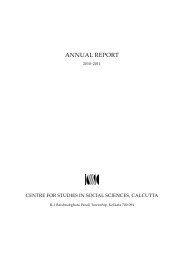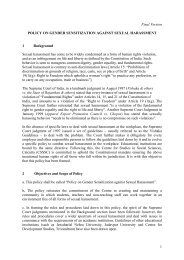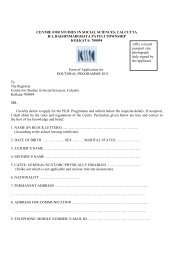Dr. Sumit Majumdar, a health economist, has been hired as a ResearchAssociate under the project.The project was completed <strong>in</strong> January 20<strong>10</strong>and the report submitted to the fund<strong>in</strong>g agency.South Asia Union Catalogue ProjectThe US National Endowment <strong>for</strong> Humanities funded triangular researchproject on historical bibliography “South Asia Union Catalogue – Phase II”has been successfully concluded. The project was a triangular researchproject of University of Chicago, Roja Muthiah Research Library and CSSSCwas housed at the CSSSC under supervision of Abhijit Bhattacharya asProject Director <strong>in</strong> South Asia <strong>for</strong> the programme. The database ofbibliographic records is available on http://sauc.uchicago.edu/.ONGOING PROJECTSRBI Endowment SchemeThe permanent research endowment scheme at CSSSC set up by theReserve Bank of India <strong>in</strong> the year 2002 <strong>for</strong> research <strong>in</strong> Industrial Economicsis currently headed by Prof. Sugata Marjit as the RBI Professor of IndustrialEconomics. Dr. Nimai Das, Research Officer <strong>in</strong> Economic look after theoperation of the RBI endowment. India Macroeconomics Annual <strong>2009</strong>, theannual publication of the endowment, edited by Prof. Sugata Marjit published<strong>in</strong> February <strong>2009</strong>. The RBI Unit at <strong>Centre</strong> plans to undertake a study onWest Bengal and the India Economy, 1977-2006. Besides, the Unit iscont<strong>in</strong>u<strong>in</strong>g with the new research work on India’s <strong>in</strong><strong>for</strong>mal sector relatedissues which shall assess the factors related to <strong>in</strong><strong>for</strong>mality-<strong>for</strong>mality tradeoffand summarise the possible measures <strong>for</strong> <strong>in</strong><strong>for</strong>mal sector <strong>in</strong> India <strong>in</strong> thepost-liberalization era.The RBI unit at the CSSSC organizes sem<strong>in</strong>ars and workshops on aregular basis and undertakes several projects on topics related to the thrustarea of research of the Unit. The Unit along with the <strong>Centre</strong> <strong>for</strong> HumanDevelopment and Human Rights (CHDHR), Rab<strong>in</strong>dra Bharati University,Kolkata organized a two-day <strong>in</strong>ternational sem<strong>in</strong>ar on ‘Globalization andDevelopment’ on January 18-19, 20<strong>10</strong>. Sugata Marjit, RBI Chair Professorpresented the <strong>in</strong>troductory speech to the International Sem<strong>in</strong>ar. The othersignificant speakers were Ronald W. Jones (Xerox Professor of Economics,University of Rochester, USA), Sule Akkoyunlu (KOF Swiss EconomicsInstitute, Zurich, Switzerland), Poonam Mehra (Indira Gandhi Institute ofDevelopment Research, Mumbai), Abhirup Sarkar (Indian Statistical Institute,Kolkata) and Rajat Acharya (Jadavpur University, Kolkata).National Tea Research Foundation ProjectTwo projects ‘A Quantitative Study of Tea Industry Market, Pric<strong>in</strong>g andOrganization and Land Resource Utilization <strong>in</strong> Tea Industry; CurrentProblems and Future Prospects with Special Reference to Labour’ fundedby the Tea Board of India are primarily focus<strong>in</strong>g on both social and economicaspects of Indian tea <strong>in</strong>dustry and are be<strong>in</strong>g carried out by Sugata Marjit,Saibal Kar, Sohel Firdos and Nimai Das. The research team developedfour different k<strong>in</strong>ds of survey <strong>in</strong>struments <strong>for</strong> big tea estates, small teaestates, bought leaf factory owners and the household survey of tea gardenworkers. The detailed survey of tea produc<strong>in</strong>g regions <strong>in</strong> North Bengal hasbeen completed and <strong>in</strong>terim report submitted. The research team is nowcarry<strong>in</strong>g out the detailed survey of the tea produc<strong>in</strong>g regions <strong>in</strong> Assam andSouth India.Embedd<strong>in</strong>g Poor People’s Voices <strong>in</strong> Local GovernanceEmbedd<strong>in</strong>g Poor People’s Voices <strong>in</strong> Local Governance is a collaborativeresearch project between University of Sheffield (UK), <strong>Centre</strong> <strong>for</strong>Development <strong>Studies</strong>, Trivandrum and <strong>Centre</strong> <strong>for</strong> <strong>Studies</strong> <strong>in</strong> <strong>Social</strong> <strong>Sciences</strong><strong>Calcutta</strong>, funded jo<strong>in</strong>tly by the Economic and <strong>Social</strong> Resaecrh Council andDFID, Government of United K<strong>in</strong>gdom.Dwaipayan Bhattacharyya is thecoord<strong>in</strong>ator of this project. Two workshops of the project have taken place<strong>in</strong> Trivandrum and Kolkata. The f<strong>in</strong>al report will be submitted by March 2011.UNICEF – <strong>Social</strong> ExclusionThe project is undertaken by the <strong>Social</strong> Exclusion Cell at the <strong>Centre</strong>compris<strong>in</strong>g Anjan Ghosh, Dhrubajyoti Ghosh, Surajit Mukhopadhyay, SohelFirdos, Saibal Kar and Sugata Marjit. Under this project a large survey isunderway on various <strong>for</strong>ms and practices of <strong>Social</strong> Exclusion <strong>in</strong> West Bengal.Navajbai Ratan Tata Trust (NRTT) project on “Tra<strong>in</strong><strong>in</strong>g <strong>in</strong> New <strong>Social</strong>Science Research Methods”The three-year Navajbai Ratan Tata Trust (NRTT) project support<strong>in</strong>g Tra<strong>in</strong><strong>in</strong>g<strong>in</strong> New <strong>Social</strong> Science Research Method at various levels at the <strong>Centre</strong> <strong>for</strong>12 13
<strong>Studies</strong> <strong>in</strong> <strong>Social</strong> <strong>Sciences</strong>, <strong>Calcutta</strong> (CSSSC) began <strong>in</strong> December 2007and is coord<strong>in</strong>ated by Sibaji Bandyopadhyay. The ma<strong>in</strong> activities of theproject are:(i)M.Phil <strong>in</strong> <strong>Social</strong> <strong>Sciences</strong> Programme at the CSSSC is of two yearsduration: 1st year, Course Work and 2nd year, Dissertation Writ<strong>in</strong>g.TheCourse Work part is designated as ‘Research Tra<strong>in</strong><strong>in</strong>g Programme’.Under the NRTT-CSSSC scholarship programme, 14 RTP students wereawarded the pre-doctoral scholarship of Rs. 4000.00 per month <strong>for</strong> 12months from August <strong>2009</strong> to July 20<strong>10</strong>.(ii) At present six post-doctoral fellows are pursu<strong>in</strong>g research work underthe CSSSC-NRTT post-doctoral fellowship programme. Three amongthem, Soh<strong>in</strong>i Guha, Srabanti Bhattacharya and. Shilp Shikha S<strong>in</strong>gh willcomplete their research work <strong>in</strong> July 20<strong>10</strong>. Three others,. Suhit K. Sen,Samarpita Mitra and. Rohan Deb Roy will f<strong>in</strong>ish their research work <strong>in</strong>November 20<strong>10</strong>.(iii) CSSSC-NRTT Annual Workshop <strong>2009</strong>Details given under Workshops and Conferences.Ford Foundation Project: “A Cultural History Archive on Eastern India”This three-year project, begun <strong>in</strong> February 2008 is headed by Prof. TapatiGuha-Thakurta, and <strong>in</strong>cludes Prof. Partha Chatterjee,Drs. Keya Dasguptaand Ros<strong>in</strong>ka Chaudhuri <strong>in</strong> its Steer<strong>in</strong>g Committee. The project is now <strong>in</strong> itsf<strong>in</strong>al year and will term<strong>in</strong>ate <strong>in</strong> February 2011.The ma<strong>in</strong> activities of the project are:I. Internship ProgrammeJyotirekha Bhattacharyya and Karabi Dutta of Media Trust Assamsuccessfully completed the technical <strong>in</strong>ternship programme <strong>for</strong> the secondyear of the Ford Foundation Project. They were attached to the CSSSC’sarchive <strong>for</strong> two months, from July 1 <strong>2009</strong> to August 31, <strong>2009</strong>. The <strong>in</strong>ternshave submitted their f<strong>in</strong>al report on completion of their <strong>in</strong>ternship and havehighly appreciated the curriculum designed by the CSSSC archive staff.Kamei Gaikhonlu from the Department of History, Manipur University wasselected <strong>for</strong> the six-month doctoral <strong>in</strong>ternship <strong>for</strong> the year <strong>2009</strong>-20<strong>10</strong>. Dur<strong>in</strong>gher fellowship period from August <strong>2009</strong> to January 20<strong>10</strong> she worked on apaper titled Evolution of Imphal City under the guidance of. Keya Dasguptaand submitted the same to CSSSC at the end of her <strong>in</strong>ternship. She utilizedthe <strong>in</strong>ternship towards sett<strong>in</strong>g up a study on the theme, Dynamics of UrbanLife <strong>in</strong> Modern Imphal, and also presented a paper titled Kangla Fort:Contested Perceptions between Archaeologists and Religious Bodies at asem<strong>in</strong>ar at the CSSSC on January 28, 20<strong>10</strong>.II. Postdoctoral fellowshipsMollica Dastider jo<strong>in</strong>ed the Ford Foundation Project as a Fellow <strong>in</strong> PoliticalScience <strong>in</strong> 2008. Her current work on Nepali Speak<strong>in</strong>g Communities <strong>in</strong>East Himalayas contributes to the larger research endeavour of the Projecton New Cultural Histories of the East. Dr. Dastider’s research <strong>in</strong>quiryengages with the construction and deconstruction of ‘caste’ Nepali culture<strong>in</strong> Darjeel<strong>in</strong>g, Sikkim and East Nepal. The common cultural geography, andher l<strong>in</strong>guistic mapp<strong>in</strong>g of the region has helped her present papers on thecommon theme of From Caste to Tribe: “Matwali Janajatis” and the CasteNepali culture <strong>in</strong> East Himalayas at two conferences between August’ 09-March 20<strong>10</strong>. Two short duration field visits to Sikkim and Kalimpong dur<strong>in</strong>g<strong>2009</strong>-<strong>10</strong> have helped her collect important specimens of scripts and textbooks <strong>in</strong> non-Aryan Himalayan languages of the Limbu, Rai , Tamang,Lepcha, Gurung and Magar tribal communities <strong>in</strong> the region. MollicaDastider’s study also <strong>in</strong> particular <strong>in</strong>tends to look at the development ofLimbu script and language, trac<strong>in</strong>g its evolution s<strong>in</strong>ce the publication of thefirst Limbu script <strong>in</strong> 1855 by Dr. Archibald Campbell. Her study reveals thatthe contemporary Limbu literary activities <strong>in</strong> the region do present anexcellent opportunity <strong>for</strong> l<strong>in</strong>guists and manuscript experts to explore and<strong>in</strong>vest <strong>in</strong> Trans-Himalayan languages <strong>for</strong> not only they present a ‘greatl<strong>in</strong>guistic watershed of non- Aryan languages’ but also bear significant sociocultural<strong>in</strong>fluences across societies <strong>in</strong> the region.Sujith Parayil resigned from the Ford Foundation full-time post-doctoralfellowship programme <strong>in</strong> July <strong>2009</strong>. He <strong>in</strong>itiated a plan of produc<strong>in</strong>g adocumentary film based on the research material available at the CSSSCarchive which he has promised to complete, notwithstand<strong>in</strong>g his resignation.The basic <strong>in</strong>tention of this documentary film is to dissem<strong>in</strong>ate the idea ofthe archival materials available at the <strong>Centre</strong> to a wider public.14 15
- Page 2 and 3: CENTRE FOR STUDIES IN SOCIAL SCIENC
- Page 4 and 5: THE CENTREThe Centre for Studies in
- Page 6 and 7: papers are i) “Choice, life and t
- Page 8 and 9: ought out by Centre for Advanced St
- Page 12 and 13: After Dr. Parayil’s resignation,
- Page 14 and 15: in remote areas and planning to dig
- Page 16 and 17: Date Speaker Topic03.12.09 Philippe
- Page 18 and 19: Geography, Education, Rural Develop
- Page 20 and 21: The workshop provided the young res
- Page 22 and 23: Name of Scholar UniversityBiswajit
- Page 24 and 25: Rosinka Chaudhuri taught PG I and P
- Page 26 and 27: 2. ‘From Spectacle to Art: The Ch
- Page 28 and 29: coordinator of i) Research Training
- Page 30 and 31: New Delhi in November 2009. He also
- Page 32 and 33: continuing as a guest columnist of
- Page 34 and 35: fund available from the Endangered
- Page 36 and 37: B. N. Mukherjee & Co.CHARTERED ACCO
- Page 38 and 39: CENTRE FOR STUDIES INR-1, BAISHNABG
- Page 40 and 41: CENTRE FOR STUDIES INR-1, BAISHNABG
- Page 42 and 43: CENTRE FOR STUDIES INR-1, BAISHNABG
- Page 44 and 45: CENTRE FOR STUDIES INR-1, BAISHNABG
- Page 46 and 47: SCHEDULE 4 - SECURED LOANS AND BORR
- Page 48 and 49: CENTRE FOR STUDIES INR-1, BAISHNABG
- Page 50 and 51: CENTRE FOR STUDIES INR-1, BAISHNABG
- Page 52 and 53: CENTRE FOR STUDIES INR-1, BAISHNABG
- Page 54 and 55: CENTRE FOR STUDIES INR-1, BAISHNABG
- Page 56 and 57: CENTRE FOR STUDIES INR-1, BAISHNABG
- Page 58 and 59: CENTRE FOR STUDIES INR-1, BAISHNABG
- Page 60 and 61:
CENTRE FOR STUDIES INR-1, BAISHNABG
- Page 62 and 63:
CENTRE FOR STUDIES INR-1, BAISHNABG
- Page 64 and 65:
CENTRE FOR STUDIES INR-1, BAISHNABG
- Page 66 and 67:
CENTRE FOR STUDIES INR-1, BAISHNABG
- Page 68 and 69:
B. N. Mukherjee & Co.CHARTERED ACCO
- Page 70 and 71:
CENTRE FOR STUDIES INR-1, BAISHNABG
- Page 72 and 73:
B. N. Mukherjee & Co.CHARTERED ACCO
- Page 74 and 75:
CENTRE FOR STUDIES INR-1, BAISHNABG
- Page 76 and 77:
CENTRE FOR STUDIES INR-1, BAISHNABG
- Page 78 and 79:
CENTRE FOR STUDIES INR-1, BAISHNABG
- Page 80 and 81:
CENTRE FOR STUDIES INR-1, BAISHNABG
- Page 82 and 83:
APPENDIX - IIBoard of Governors
- Page 84 and 85:
APPENDIX - IIIMembers of the Academ








